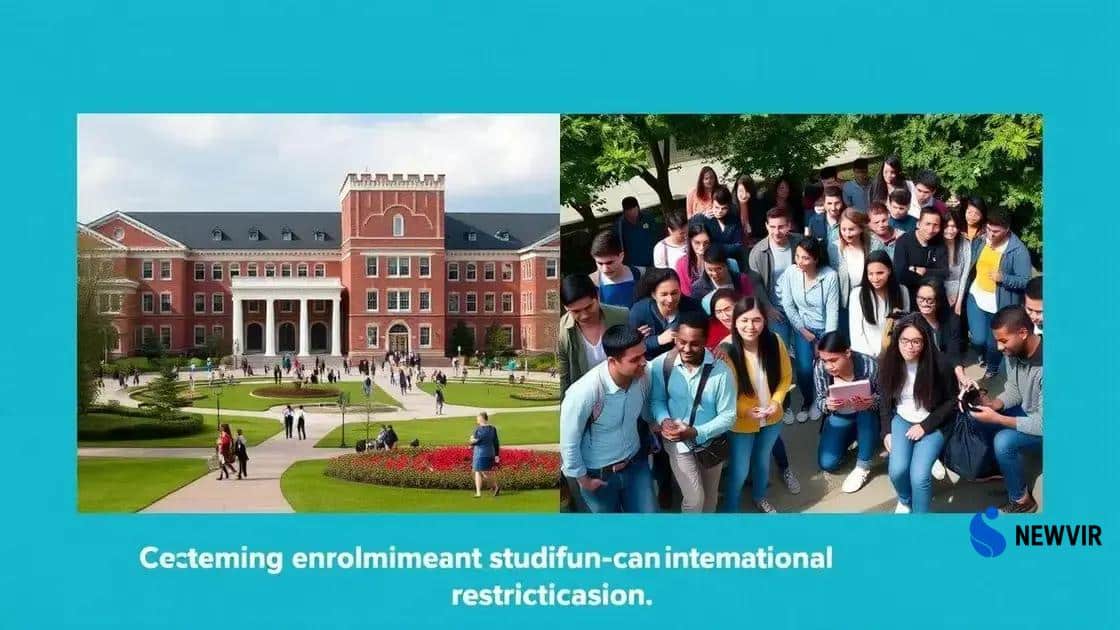Restrictions placed on international student admissions raise concerns

Restrictions placed on international student admissions significantly limit student mobility, decrease cultural diversity, and impact the competitiveness and financial stability of educational institutions globally.
Restrictions placed on international student admissions have stirred significant discussion among educators and students alike. What do these limits mean for aspiring scholars?
Understanding current restrictions on international students
Understanding the current restrictions on international students is vital for schools and aspiring scholars. These policies can shape educational paths for many.
Types of Restrictions
Various restrictions exist, each impacting international students differently. Schools may impose limits based on:
- Visa Regulations: Different countries have unique visa requirements that can affect student admissions.
- Quota Systems: Some institutions implement quotas on the number of international students.
- Language Proficiency: Higher language barriers can restrict admissions for many students.
These factors can confuse students as they try to navigate the admissions process. Understanding these rules helps students plan their studies effectively.
The Role of Government Policies
Government policies significantly influence the restrictions placed on international students. For instance, countries may adjust policies based on geopolitical situations or economic needs.
Additionally, schools may face pressure to produce a certain number of local graduates, which can lead to restrictions on international admissions. This ongoing shift often leaves potential students in doubt about their future.
For many, the hope of studying abroad is tied to their career aspirations. However, the reality of stringent restrictions can be a barrier to their dreams. Staying informed helps students adapt their plans and explore alternatives.
Overall, understanding these current restrictions empowers students to make informed choices about their education journeys.
The impact of restrictions on global education
The impact of restrictions on global education is profound and far-reaching. Many students dream of studying abroad, but restrictions can hinder these aspirations.
Effects on Student Mobility
When restrictions increase, fewer international students can enroll in universities worldwide. This creates an environment where educational diversity is diminished.
- Reduced Cultural Exchange: A decline in international students means less cultural interaction.
- Financial Strain on Universities: Schools rely on tuition from international students, and fewer students can lead to financial challenges.
- Decreased Global Competitiveness: Countries with strict admissions policies may fall behind in attracting top talent.
These factors contribute to a less vibrant academic landscape, impacting everyone involved. Schools may lose out on innovative ideas and diverse perspectives that international students bring.
Long-term Consequences
Long-term restrictions can have lasting effects on educational systems. Countries may find themselves unable to compete globally, resulting in a generation of students who miss opportunities for personal and academic growth.
Additionally, as local institutions grapple with fewer international enrollments, they may struggle to maintain their global reputation. This situation leads to a ripple effect, affecting future students and the overall quality of education.
Students facing these restrictions often explore alternative paths, such as online courses or programs in less restrictive countries. The push for a more accessible global education system is essential for the future.
Ultimately, understanding the impact of restrictions on global education helps highlight the importance of advocating for more open and inclusive policies.
Case studies: effects on student enrollment

Examining case studies provides insight into the effects on student enrollment due to restrictions on international admissions. These examples shed light on real-life scenarios faced by students and institutions.
Example 1: University of Sydney
The University of Sydney faced a significant drop in international student applications after new visa regulations were established. The restrictions made it harder for students from certain countries to gain admission.
- Enrollment Drop: Applications decreased by over 20% within one year.
- Diverse Programs: The university’s diverse programs suffered, limiting student perspectives.
- Financial Impact: A reduction in international students led to funding shortages for various initiatives.
This case highlights the challenges universities confront when student mobility is restricted.
Example 2: University of California System
In contrast, the University of California system introduced targeted outreach programs to attract international students despite restrictions. Their approach helped maintain enrollment levels.
By adapting to the changed environment, they were able to:
- Enhance Communication: Strengthening ties with potential students through virtual events.
- Offer Flexible Admissions: Adjusting requirements allowed more students to apply.
- Focus on Diversity: Commitment to retaining a diverse student body enhanced their appeal.
This illustrates how proactive measures can mitigate the negative impacts of restrictive policies on international student enrollment.
Every case underscores the importance of understanding how restrictions alter the educational landscape. Analyzing these results is essential for institutions aiming to adapt to changing admissions environments.
Controversies surrounding admissions policies
Controversies surrounding admissions policies for international students are prevalent in many educational settings. Different regions and institutions often adopt varying approaches, leading to debates and discussions.
Debate Over Fairness
One major point of contention is fairness in admissions. Critics argue that stringent policies disadvantage students from developing countries.
- Equity in Access: Many believe that admissions should reflect global equity, not economic status.
- Merit vs. Background: Balancing merit-based admissions with equitable access remains challenging.
- Diversity in Classrooms: Critics highlight that diverse classrooms benefit all students.
Programs aiming for inclusivity often face resistance, with opponents questioning their effectiveness.
Influence of Politics
The influence of politics also complicates admissions policies. Governments sometimes impose rules that affect students’ chances to study abroad based on current political climates.
For instance, tensions between countries can lead to:
- Visa Restrictions: Increased scrutiny on visa applications affects student mobility.
- Selective Admissions: Some universities may favor students from specific countries over others.
- Changing Requirements: Frequent alterations in policies can create confusion among prospective students.
These changes not only impact students but also affect global perceptions of educational institutions.
Furthermore, the discussion about whether admissions policies should prioritize local students is ongoing. Balancing local and international interests poses a challenge for many universities.
Future implications of current restrictions
The future implications of current restrictions on international student admissions are concerning for educators and policymakers. As these restrictions evolve, they may significantly affect global education systems.
Changing Demographics
One major effect could be a shift in student demographics. As restrictive policies continue, fewer students from developing nations may have access to international education.
- Increased Local Enrollment: Universities may see more local students, but they can miss out on global talent.
- Diversity Loss: A decrease in international students impacts cultural diversity in classrooms, affecting the learning environment.
- Innovation Decline: Less diversity can lead to fewer innovative ideas, essential for a thriving academic community.
As demographics shift, institutions might need to adapt to a new educational landscape.
Impact on Global Competitiveness
The competitiveness of a country’s universities may also be affected. Nations that impose heavy restrictions risk losing their status as attractive study destinations.
As potential students turn to countries with more open admissions policies, the former may experience:
- Decreased Rankings: Universities may see a drop in global rankings if they can’t attract top talent.
- Funding Challenges: Less tuition income could lead to budget cuts and reduced program offerings.
- Shift in Reputation: A negative reputation may develop, making it harder for schools to regain their appeal.
Understanding these future implications is essential for institutions to remain relevant and competitive in a rapidly changing world.
FAQ – Frequently Asked Questions about International Student Admissions
What are the main restrictions on international student admissions?
Main restrictions include visa regulations, language proficiency requirements, and quota systems that limit the number of international students.
How do these restrictions affect global education?
Restrictions can lead to reduced student mobility, decreased cultural diversity in classrooms, and potential financial challenges for universities.
What are the long-term implications for universities?
Long-term implications may include a decline in global competitiveness, decreased enrollment, and loss of funding, which could impact program offerings.
What can universities do to adapt to these restrictions?
Universities can adapt by enhancing outreach programs, offering flexible admissions requirements, and focusing on maintaining diversity within their student bodies.






